Kite Surfing Adventures in the Florida Keys
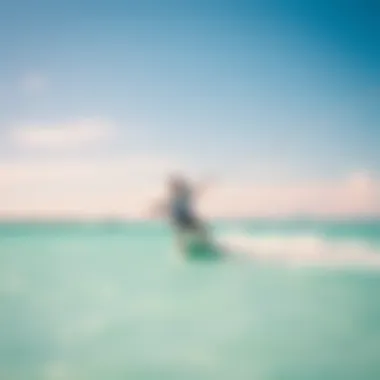
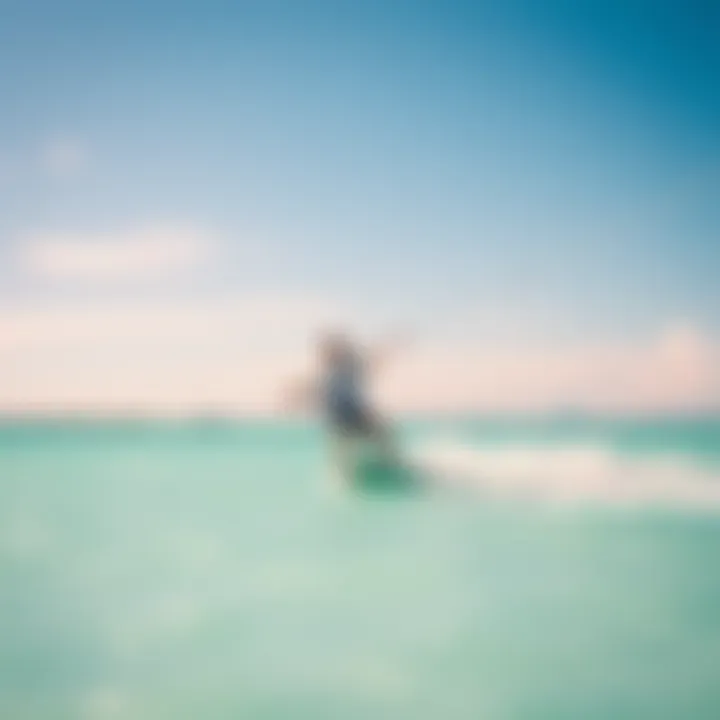
Intro
Kite surfing in the Florida Keys is a thrilling pursuit that combines adrenaline with the serene beauty of the ocean. It's a unique sport that attracts both novice enthusiasts and seasoned riders alike. Between the cool breezes and the stunning backdrop of turquoise waters, finding the right spot to catch the wind can feel like a treasure hunt. The vibrant culture surrounding this sport offers a wealth of knowledge and experience, which makes diving into it all the more exciting. Here, we present a comprehensive guide that not only navigates the best locations and optimal weather but also delves into the essential gear that'll keep you kiting safely and effectively. Plus, understanding the local regulations and safety measures can make all the difference for a successful kiteboarding adventure.
Equipment Insights
When it comes to kite surfing, having the right equipment is as crucial as the wind that fills your sails. Whether you’re just starting or are an experienced rider looking to upgrade, understanding your gear can enhance your performance dramatically.
Latest Gear Reviews
In the fast-paced world of kite surfing, continuous innovations sweep the market, each promising to elevate your experience. Brands like North Kites and Cabrinha consistently push boundaries, introducing new products that cater to every surfer's need. For instance, the North Orbit kite boasts an agile performance and stability, perfect for both wave riders and those who prefer flat water. Furthermore, the Cabrinha Switchblade is renowned for its versatility, making it suitable for a variety of riding styles.
There are a few crucial factors to consider when selecting your equipment:
- Kite Size: Depending on your weight and local wind conditions, you may need different kite sizes. A larger kite provides more lift, ideal for lighter winds.
- Board Type: Freestyle boards offer light construction, while more robust wave boards provide better control in choppy waters.
- Harness Comfort: An ill-fitting harness can ruin your day; investing in one that suits your body type is worthwhile.
Essential Gear Maintenance
To maximize your gear's life and performance, regular maintenance is essential. Here are some key maintenance tips:
- Drying: Always dry your kite before packing it away. This prevents mold and mildew from forming on the fabric.
- Inspecting Lines: Check for any frays or damage on your lines before each outing. Even the smallest sign of wear can lead to catastrophic failure during a ride.
- Storing Properly: Store your kite in a cool, dry place away from direct sunlight to prevent UV damage.
"Maintaining your gear is like tuning a fine instrument; small adjustments can lead to big changes in performance."
Understanding and maintaining your equipment can extend its life span and, more importantly, keep you safe out on the water. The right gear, well-cared-for and suited to your skill level, will empower your kitesurfing experience in the Keys.
Technique Exploration
As critical as the right equipment is, mastering the techniques of kite surfing can truly unlock the sport's potential. From first-time flyer to aerial trickster, techniques can shape how you experience kiteboarding.
Beginner Techniques
Getting started with kite surfing involves grasping some basic techniques that form the foundation for more advanced maneuvers. Here are some essentials:
- Body Dragging: Before jumping on the board, practice body dragging to understand how to control the kite in the water. This skill is invaluable for self-rescue, should you find yourself in a pickle.
- Water Start: Timing is everything here. As you pull on your back hand, position your board to catch the water's surface and rise smoothly.
- Controlling Speed: Learning to adjust your speed using the kite is crucial. Pulling the kite closer leads to forward momentum, while pushing it away slows you down.
Advanced Maneuvers
For those who feel the wind beneath their wings and want to take it to the next level, consider honing these advanced techniques:
- Jumping: This is a crowd favorite. Coordinate with your kite—kick off at the right moment while pulling hard on the backhand.
- Transitions: Don’t just ride straight; practice smooth transitions to change directions without losing momentum.
- Tricks and Spins: As you get comfortable, try adding spins or grabs to your jumps to impress fellow riders.
It’s crucial to remember that practice makes perfect. The Keys, with its forgiving waters and plentiful space, is an excellent playground for both novice and advanced kite surfers to hone their skills and try new techniques.
Intro to Kite Surfing in the Florida Keys
Kite surfing represents a fascinating intersection of skill, thrill, and nature's elements. It's not merely a sport; for many, it morphs into a lifestyle that fosters a profound connection with water and wind. In the idyllic landscape of the Florida Keys, this water sport finds its perfect home, captivating enthusiasts from novice to the elite level.
The Florida Keys, with their stunning views and inviting waters, provide a unique blend of environments suited for kite surfing. From the azure waters to the consistent winds, the geographical offerings make it easy to see why kite surfers flock here. This region features diverse spots, each offering distinct conditions that cater to various skill levels and preferences.
Benefits of Kite Surfing in the Keys
Engaging in kite surfing carries a myriad of benefits. Apart from the obvious thrill and excitement, it promotes physical fitness, improves balance, and enhances coordination. Plus, the stunning backdrop of the Florida Keys enhances the entire experience. The salt-kissed air and the warm sun can rejuvenate one's spirit like nothing else.
Moreover, the social aspect cannot be overlooked. Kite surfers often bond over shared experiences and mutual challenges. In places like Key West or Islamorada, you'll find a community of riders who share tips, tricks, and tales of their adventures. This connection to fellow kite boarders enhances not only individual skills but also the overall enjoyment of the sport.
Considerations When Exploring Kite Surfing
Despite its exhilarating nature, potential participants should approach kite surfing with due diligence. This sport involves a certain degree of risk, and understanding local regulations and safety protocols becomes paramount. Every locality may possess distinct rules regarding kite surfing, which is critical to ensuring both personal safety and respect for the environment.
In summary, diving into the world of kite surfing in the Florida Keys opens the door to experiences that are both exhilarating and meaningful. The unique conditions and vibrant communities create a landscape where passion thrives and skills flourish. As one sets sail into this adventure, every wave and breeze tells a story, waiting to be explored.
Geographical Overview of the Florida Keys
The Florida Keys, an archipelago stretching over 120 miles off the southern coast of Florida, serves as a captivating canvas for kite surfing enthusiasts. This geographical configuration plays a vital role in shaping the kiteboarding experience, as the unique island layout, wind patterns, and vast bodies of water create a dynamic environment for riders of all skill levels.
Island Layout and Accessibility
The Keys consist of over 1,700 islands, but only about 43 are inhabited. The most easily accessible ones include Key Largo, Islamorada, and Key West, each offering distinct environments catering to different kite surfing preferences. The Overseas Highway, a scenic drive that connects the islands, makes accessibility a breeze. Riders can easily hop from one island to another, opening the door to diverse kite surfing conditions and experiences.
Significant Locations for Kite Surfing
Key Largo
Key Largo is often dubbed the "Diving Capital of the World," but it also packs a punch in the kite surfing department. The waters are generally shallow, which is great for beginners learning the ropes. It's a hotspot due to its accessibility from Miami and beautiful scenery. The stunning coral reefs offer a backdrop that many riders cherish, making each session not only thrilling but also visually appealing. The area's relatively calm waters mean less chance of wipeouts, thereby promoting a more enjoyable learning environment.
- Advantages:
- Disadvantages:
- Shallow waters ideal for beginners
- Close proximity to Miami makes it easily accessible
- Can get crowded during peak tourist seasons
Islamorada
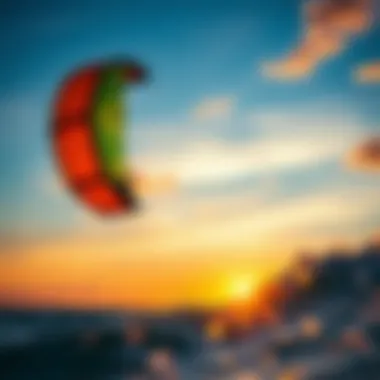
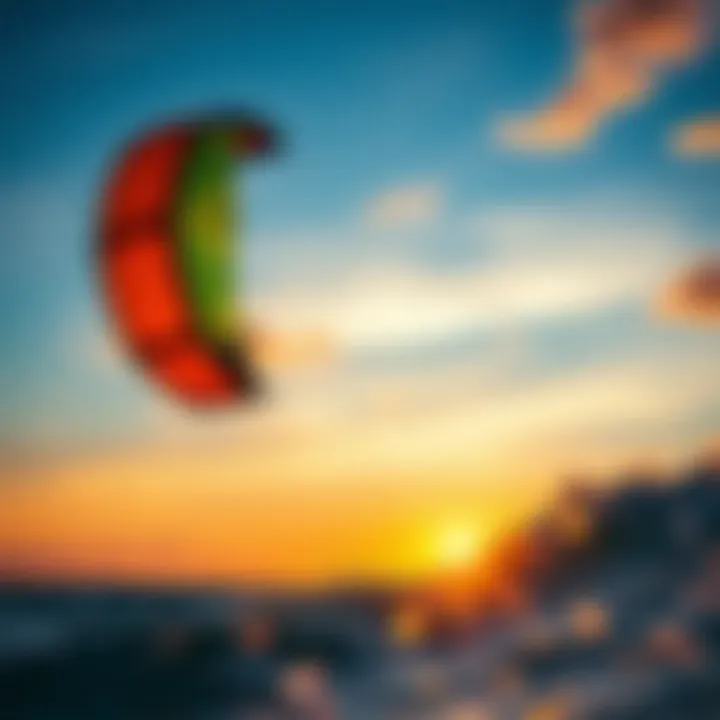
Known as the "Sportfishing Capital of the World," Islamorada is equally enticing for kite surfers. The wind conditions here tend to be more consistent, providing ample opportunity for advanced riders to test their skills. The landscape is dotted with beautiful beaches and secluded spots, making it a favorite for those preferring a more relaxed atmosphere. The extensive flatwater areas are perfect for jumping and tricks, bringing in the thrill-seekers who appreciate the challenge.
- Advantages:
- Disadvantages:
- Consistent wind patterns ideal for advanced riding
- Secluded beaches offer a tranquil kite surfing experience
- Some areas may have strong currents, requiring caution
Key West
As the southernmost point in the continental United States, Key West boasts a vibrant atmosphere. This lively island offers kite surfing experiences near the turquoise waters of the Atlantic Ocean and the Gulf of Mexico. Here, kite surfers can enjoy the warm trade winds while being surrounded by a community that celebrates watersports. It's a hotspot for competitions and kite festivals that provide additional exposure to the sport.
- Advantages:
- Disadvantages:
- Rich cultural scene enhances the overall experience
- Proximity to various kite surfing events and competitions
- Wind conditions can be unpredictable
"The Florida Keys are more than just a kiteboarding destination; they are a lifestyle wrapped in waves and warm breezes."
For more detailed weather forecasts and wind patterns, visit Weather.com or check local kiteboarding forums on Reddit.
Discovering these hotspot locations lays the groundwork for an exceptional kite surfing adventure.
Ideal Weather Conditions
Weather plays a pivotal role in kite surfing, especially in a locale as dynamic as the Florida Keys. Kiteboarders must be attuned to specific weather phenomena that not only influence the thrill of riding but also directly impact safety. The coastal wind, sunlight intensity, and tropical elements make Florida an intriguing backdrop for this aerial sport. Having an understanding of these factors can enhance one's experience—making the difference between a frustrating day on the water and a memorable adventure.
Seasonal Wind Patterns
Wind is the lifeblood of kite surfing. The Florida Keys, with their unique geography, creates distinct wind patterns throughout the year. During the winter months, the winds typically blow from the north-east, offering consistent and robust conditions perfect for kiteboarding. The winter trade winds can average anywhere from 15 to 25 knots. This is arguably the best time for kite surfers—from the novice to the seasoned expert—seeking reliable winds and moderate temperatures.
As spring approaches, the winds begin to shift. The warmer months might bring more unpredictable gusts. During this time, kite surfers might encounter thermals that create sudden changes in wind direction, making it essential to remain alert. Those looking to ride during summer should be equipped with skill and the know-how to read nuanced wind shifts.
"Mastering the art of reading the wind can often be the difference between a day of fun and a day of frustrations on the water."
Moreover, local spots like Key Largo or Islamorada may experience unique wind pockets due to their geographic orientation. Not every area will have the same strength of wind, so it's beneficial to do some scouting. Checking out local forecasts, such as those from the National Weather Service, can provide details on wind strengths, making it easier for kite surfers to plan their sessions effectively.
Effects of Tropical Weather
Tropical weather can be a double-edged sword for kite surfers venturing in the Florida Keys. The sunny disposition of the region can often belay the lurking challenges posed by weather systems that churn through the Caribbean. As any seasoned rider knows, the lure of the warm waters and azure skies is sometimes interrupted by the volatility of tropical storms.
Hurricane season, which runs from June to November, introduces uncertainty. While experienced kite surfers may find opportunities to surf in strong winds and waves generated by these storms, safety must be the priority. The National Hurricane Center provides resources to track storm developments. A keen eye on weather updates will be crucial in making decisions about riding during this seasonal upheaval.
In addition, tropical storms can stir up unusual currents. These currents, whether from an upcoming storm or heavy rains, can transform serene spots into hazardous waters. Respecting local tide information and advisories is key to ensuring a safe kiteboarding experience.
Understanding these elements of tropical weather can prepare kite surfers to either seize the day or err on the side of caution. It's not just about catching the right wind; it's about recognizing the environment and making informed choices while enjoying the beauty of the Florida Keys.
Equipment Essentials for Kite Surfing
When embarking on the exhilarating journey of kite surfing, having the right equipment is not simply a recommendation—it's a necessity. The equipment you choose not only affects your performance but also plays a pivotal role in ensuring your safety on the water. Let's break down the three main components every kite surfer should understand: the types of kites, the various harnesses and boards, and the critical safety gear.
Kite Types and Their Usage
Kites are the heart of kite surfing, and choosing the right one can significantly influence your experience. There are mainly two types of kites used in the sport: inflatable kites and foil kites.
- Inflatable Kites: These are constructed with air-filled bladders that keep the kite rigid. They are generally popular among beginners because they provide stability. Moreover, inflatable kites are better for handling in turbulent winds and produce substantial power, making them suitable for various conditions.
- Foil Kites: Lacking the inflatable bladders, foil kites rely on their fabric to maintain their shape. They are typically used by more experienced kite surfers because they require a higher skill level to control. Foil kites are lighter and more compact, making them a preferred choice for backcountry adventures.
Understanding these differences can help you select a kite that aligns with your skill level and the conditions in the Florida Keys. For instance, in lighter winds typical of summer, an inflatable kite may work better, while a foil kite could be optimal for stronger gusts.
Harnesses and Boards Overview
Your kite is only as good as the connections you make with it. That's where harnesses and boards come into play.
- Harnesses: There are two primary types: waist harnesses and seat harnesses. Waist harnesses sit around your waist and provide good freedom of movement, ideal for those who prioritize maneuverability. On the other hand, seat harnesses provide more support for your back and are often recommended for beginners who might need extra stability while learning.
- Boards: The type of board you choose affects your performance on the waves. Twin-tip boards are the most common, allowing riders to go both ways without turning. They're versatile and perfect for all types of riders. Alternatively, directional boards are more suited for advanced riders who enjoy surfing waves, as they are designed to ride in one direction only.
Choosing the right harness and board can elevate your kite surfing experience significantly, ensuring that your body is well-supported and you have the right tool for the job.
Safety Gear Requirements
Safety gear is paramount, and it should never be an afterthought. Kite surfing, while thrilling, carries inherent risks that can be mitigated through proper equipment.
- Helmet: Protecting your head from falls or collisions is crucial. A kite-specific helmet provides the best protection because it’s designed to withstand the rigors of the sport.
- Impact Vest: This gear not only adds buoyancy but also provides impact protection. In the unpredictable waters of the Keys, an impact vest can absorb shocks from falls and keep you afloat.
- Leash: A reliable safety leash connects you to your kite, ensuring that even if you fall, you won't lose control of your equipment. It's a simple yet effective way to maintain safety on the water.
Adhering to these safety gear recommendations can mean the difference between a close call and a disaster.
Always prioritize safety gear. It’s better to have it and not need it than to need it and not have it.
Safety Considerations
Kite surfing can be an exhilarating sport. However, it carries its own set of risks, emphasizing the necessity of safety precautions. Understanding safety considerations not only protects the individual kite surf but also enhances the experience for everyone sharing the water. Each thrilling ride can turn dangerous without the proper awareness of safety measures, making it crucial for enthusiasts to stay informed and prepared.
Understanding Local Regulations
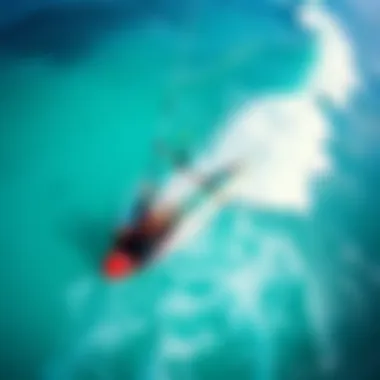
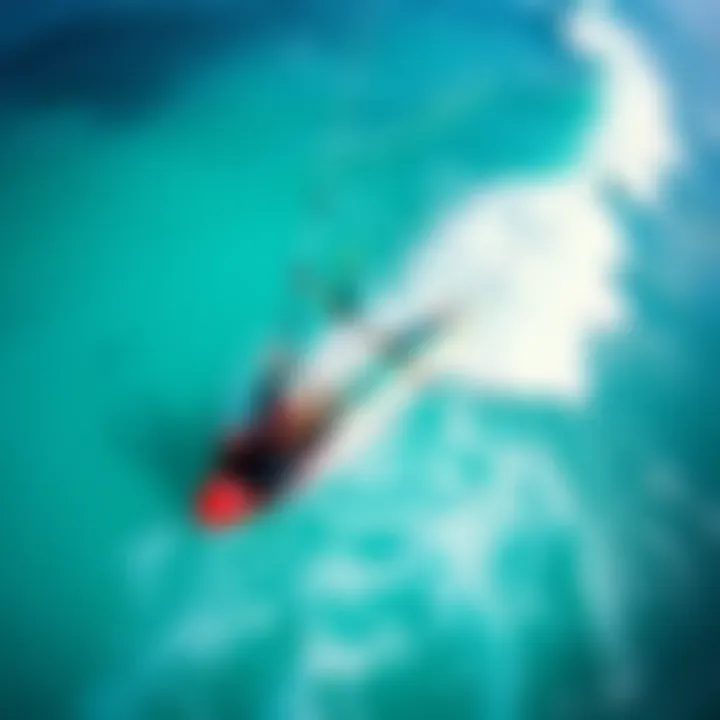
Different locations may enact specific regulations regarding kite surfing practices, and the Florida Keys is no exception. Adhering to local regulations not only ensures safety but also reflects the respect kiteboarders should have towards the delicate environment around them.
Considerations include:
- Designated Areas: Understanding where kite surfing is permitted is essential. Many places might have restricted zones to protect both wildlife and swimmers. Failing to follow these areas can lead to accidents or fines.
- Permits and Fees: Some regions might require kiteboarders to obtain permits or pay certain fees. It’s important to check with local authorities or websites to stay updated.
- Guidelines for Conduct: Regulations often include guidelines on how to conduct oneself in and around other riders, which is vital to ensure a safe and enjoyable experience.
"Knowing and following local regulations is not just about avoiding penalties; it’s about creating a respectful and responsible kite surfing culture."
Emergency Protocols
In case of unforeseen events while kite surfing, established emergency protocols become crucial. These can vary depending on location and circumstances, but some fundamental steps should be universally understood:
- Situational Awareness: Always be aware of your surroundings, including weather changes and nearby surfers. The ocean can change lashes quickly, so spotting signs may make a significant difference.
- Emergency Contacts: Knowing who to contact in case of an emergency can save valuable time. Familiarize yourself with local coast guard numbers and any additional emergency services available.
- Rescue maneuvers: Being equipped with basic rescue techniques can be crucial. Whether it’s recovering someone who has fallen off their board or if you find yourself in distress, knowing how to manage these situations is part of being a responsible kiteboarder.
- Safety Equipment: Having safety gear like a whistle, a buoyancy aid, and well-maintained kites and harnesses on hand can play a vital role in emergency preparedness.
While kite surfing in the Florida Keys offers an unmatched experience, safety should never take a back seat. By understanding local regulations and adhering to emergency protocols, kiteboarders not only protect themselves but also contribute to the integrity and safety of the kite surfing community.
Cultural and Environmental Impact
Kite surfing in the Florida Keys is more than just an exhilarating sport; it intertwines with the local culture and environment in significant ways. Understanding the cultural and environmental impact of kite surfing is essential for anyone interested in engaging with this vibrant community. It’s about recognizing how this sport influences and is influenced by the local way of life, as well as the ecosystems that support it.
Local Communities and Kite Surfing
Kite surfing not only draws enthusiasts from afar but also creates a close-knit community among locals. The sport fosters a vibrant culture, where local riders become mentors and friends to those just starting out. Schools and shops, like those in Key West and Islamorada, become community hubs where people can share tips, experiences, and equipment recommendations.
The locals often organize events and competitions, bringing together residents and visitors alike, further enriching the cultural fabric of the Keys. This camaraderie creates a strong sense of place and belonging for participants, while enhancing the visibility of kite surfing in the region.
However, it’s crucial to respect local customs and traditions when engaging in this sport. For instance, some beaches may have specific rules about where to launch and land kites, influenced by local fishing practices or conservation efforts. Engaging with the community respectfully can lead to better experiences for everyone involved while also ensuring the sport remains accepted and supported in local areas.
Environmental Considerations
With the allure of gleaming waters, the environmental impact of kite surfing cannot be overlooked. The Keys are home to delicate ecosystems, including coral reefs and seagrass beds, that can be affected by human activities. It’s essential for enthusiasts to be mindful of sustainability practices.
- Avoid Crowding Sensitive Areas: Kite surfers should navigate away from marine protected areas to minimize disturbance to wildlife.
- Responsible Gear Use: The materials used in kite surfing gear can impact the environment negatively if not handled and disposed of properly. Using eco-friendly equipment is a proactive step for riders.
- Leave No Trace Behind: Ensuring that beaches remain clean by picking up after oneself contributes to the maintenance of the natural beauty of these areas.
"Protecting the environment is just as vital as enjoying it; every kite surfer should feel the responsibility to help preserve the beauty of our surroundings."
Indeed, the integration of kite surfing into the local culture and ongoing efforts to minimize environmental impact are both crucial to the sustainability of this beloved sport. By engaging with local communities and being conscious of ecological responsibilities, kite surfers can ensure that the thrill of riding the winds in the Florida Keys can be enjoyed by generations to come.
Techniques for Effective Kite Surfing
Kite surfing is not just a sport; it's an art that blends skill, timing, and a certain amount of finesse. The techniques you master can significantly enhance your experience on the water. Proper techniques can lead to smoother rides, improved safety, and a more enjoyable overall experience. It's critical to grasp the different approaches suited for various skill levels, as each technique serves a distinct purpose in developing a kite surfer's ability. Mastery of these methods also fosters confidence in your talents, inspiring you to tackle more challenging maneuvers in the future.
Beginner Techniques
Diving into kite surfing as a beginner can be a daunting task, but it doesn't have to be. The key is to focus on the basics, allowing yourself time to develop good habits. Here are some essential techniques for newcomers:
- Body Dragging: This technique helps you get comfortable with kite control in water. While you can learn this on land, the sensation of being pulled through water helps in grasping the dynamics of the kite. To practice, simply launch the kite and let the wind pull you along the water.
- Water Starts: Knowing how to transition from sitting in the water to standing on the board is fundamental. It’s about balancing your weight and waiting for the right moment—when the kite is at the correct angle to generate power. Keep your body low and your eyes focused on the horizon.
- Safety Position: Always be aware of your surroundings and position your body appropriately. The safety position keeps the kite low and stable, preventing it from flipping in gusts of wind. This is crucial, especially for beginners, to avoid accidents.
By assimilating these beginner techniques, you’ll build a strong foundation that will serve you well as you progress in your kite surfing journey.
Intermediate to Advanced Skills
Once you’ve nailed down the basics, it’s time to elevate your skills. Intermediate to advanced techniques challenge your abilities, pushing you toward greater achievements in your kite surfing experience. Here are some key areas to focus on:
- Jumping: The thrill of soaring above the water is a major appeal of kite surfing. Start small by practicing pop-offs—using the board’s edge to launch yourself into the air. Control is paramount here: managing your kite’s position is crucial for a smooth landing.
- Tricks: As you gain confidence, consider adding tricks to your repertoire. Moves like the handle pass or backroll require precise kite control and timing. Practice these on flat water for easier learning, and don’t hesitate to consult more experienced riders or instructors for tips.
- Carving: Developing an understanding of carving will enhance your fluidity on the water. This involves shifting your weight correctly and engaging your edge to glide seamlessly through the waves. It’s a wonderful way to combine your skills while maintaining speed and flow.
Ultimately, honing these techniques not only amplifies your enjoyment but also enriches your relationship with the sport itself.
"The only way to grow is to push your limits, and great kite surfers are made, not born."
As you work through these stages, remember that practice breeds improvement. Each new skill will add an additional layer to your kite surfing journey, opening doors you might never have imagined.
Kite Surfing Schools and Instruction
When it comes to kite surfing in the Florida Keys, having the right guidance can make or break the experience. Kite surfing schools are essential for anyone looking to dive into this exhilarating sport. They provide not only the technical skills necessary to safely navigate the waters but also a sense of community among fellow enthusiasts. A good school can set the foundation for a successful, enjoyable journey, whether you are a beginner or seeking to refine your skills.
Choosing a Suitable School in the Keys
With many options available throughout the Florida Keys, selecting a kite surfing school requires careful consideration. First off, it’s wise to look for schools that have certified instructors. These professionals typically hold certifications from recognized bodies like the International Kiteboarding Organization (IKO) or the Professional Air Sports Association (PASA). This assures you that you're being taught by someone who knows their stuff and can impart crucial safety information.
Don't forget to read reviews or ask for recommendations from locals or fellow kite surfers. Schools with a solid reputation often have loyal following and a track record in teaching effective techniques. Consider also the size of the classes. Smaller groups make for more personalized attention, allowing instructors to tailor their teaching methods to individual needs and learning speeds.
Here are some questions to ponder when choosing a kite surfing school:
- Does the school offer beginner and advanced courses?
- Are the lessons conducted in safe, controlled environments?
- What equipment is provided, and is it well-maintained?
- How flexible is their scheduling?
What to Expect from Lessons
Once you’ve chosen a school, it’s helpful to know what to expect from the lessons. Typically, kite surfing lessons begin on land where students learn about the equipment, safety precautions, and fundamental techniques. Instructors might use simulations to enhance understanding before venturing onto the water.
As students progress, they can expect to engage in practical sessions that include:
- Kite Control: Learning how to steer and manage the kite is crucial. Expect to practice flying the kite on the beach before heading to the water.
- Body Dragging: This step is about getting comfortable in the water while being pulled by the kite, an essential skill for beginners.
- Water Starts: After mastering body dragging, the next stage is standing up on the board while controlling the kite. This can be challenging but immensely rewarding.
- Self-Rescue Techniques: Instructors will teach you how to manage a situation should things go awry.
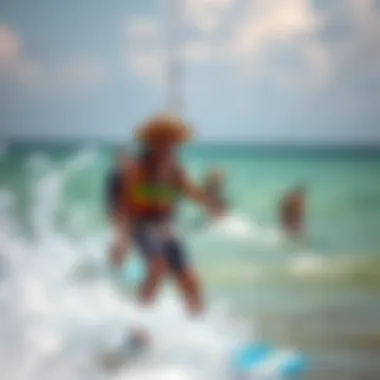
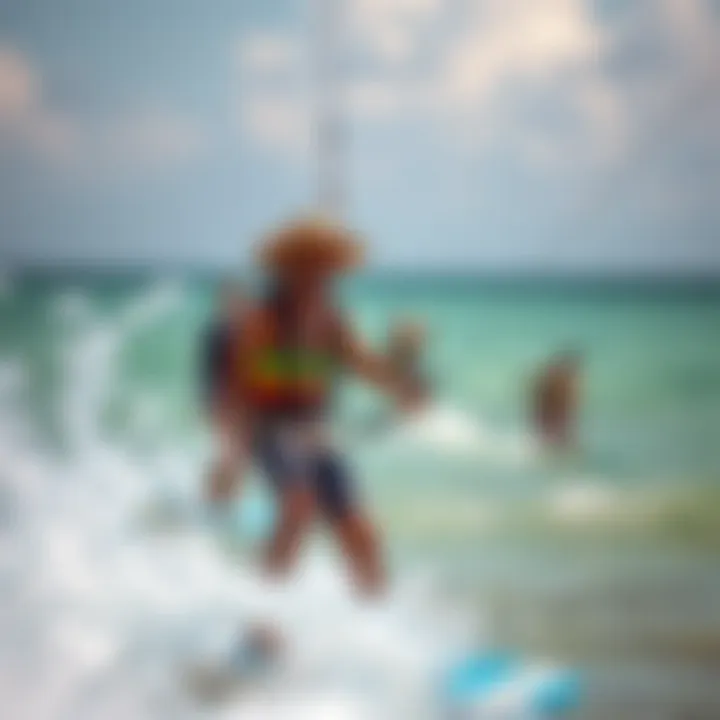
During lessons, it is common to receive feedback. This constructive criticism will help you refine your technique as you go along. Many schools also encourage practice outside of lessons, as kite surfing is a sport where muscle memory plays a significant role.
Local Competitions and Events
Kite surfing in the Florida Keys is not just about thrilling rides and stunning vistas; it encompasses a vibrant community spirit fostered through local competitions and events. These gatherings play a vital role in promoting kiteboarding as a social sport and facilitating connections among enthusiasts. They create platforms for riders to showcase their skills and gain insights into the sport’s evolving dynamics.
Overview of Annual Competitions
Every year, the Florida Keys host a range of kite surfing competitions that attract participants not only from the region but from all around the globe. One of the standout events is the Key West Kiteboarding Freestyle Competition, usually held in the spring, where riders demonstrate their incredible agility and flair. Such competitions are more than just showcases of talent; they foster a sense of community and camaraderie among participants and spectators alike.
In addition to that, the Islamorada Kiteboarding Festival is another major event, often celebrated for its spirited environment and lively atmosphere. These annual competitions are pivotal in advancing kite surfing's popularity, making it a big part of local culture.
Key components of these competitions include:
- Disciplines and Categories: Riders compete in various categories such as freestyle, racing, and big air, allowing for a range of skills to shine.
- Judging Criteria: Competitors are assessed based on factors like technical difficulty, creativity, and execution, giving a clear benchmark for aspiring riders.
- Community Involvement: Local businesses often sponsor these events, enhancing community bonds and encouraging tourism in the area.
"Competitions aren’t just about winning; they’re an opportunity to push personal limits and learn from each other."
How to Participate or Spectate
Getting involved in kite surfing competitions or simply spectating can be an exhilarating experience. If you're a kiteboarder keen on throwing your hat in the ring, the steps to joining are straightforward.
- Check Registration Details: Most events post registration details online within several months leading up to the competition. Websites such as kiteboarding.com or local event pages are useful resources.
- Prepare Your Equipment: Ensure that your gear is competition-ready. This often means more than just your kite and board; you might want to check for wear and ensure everything meets the regulations announced by organizers.
- Understand the Schedule: Familiarize yourself with the competition timetable, including heats and practice times.
- Community Engagement: Engage with fellow kiteboarders and fans online. Platforms like Facebook groups or Reddit provide ample opportunity to connect and gather information.
If you’re more inclined to watch than compete, spectating these events can be a thrill. Find a good vantage point, perhaps settle in at Smathers Beach in Key West, or anywhere along the shore where you can catch all the action. Don’t forget your camera and sunscreen!
By engaging with the kite-surfing community, whether you’re riding the waves or cheering from the shore, you’re partaking in an experience that transcends mere sport—it's an adventure and an expression of freedom.
Best Practices for Kite Surfing Etiquette
Engaging in kite surfing is not only about catching wind in your sails, but also about sharing the water with fellow enthusiasts. Best practices for kite surfing etiquette are essential for ensuring an enjoyable experience for everyone involved. Following these unwritten rules fosters a sense of community while minimizing accidents. Adhering to basic etiquette enhances safety, cooperation among riders, and the preservation of natural habitats, making your kite surfing adventure truly memorable.
Respecting Other Riders
In any sport that takes place in a shared environment, being mindful of others is key. When kite surfing, it's vital to keep an eye on your surroundings and be considerate of those around you. Here are several core points to keep in mind:
- Keep Distance: Maintain a safe distance from other riders. This not only prevents collisions but gives everyone room to maneuver safely. A good rule of thumb is to keep at least a kite’s length away from others.
- Right of Way: Understand who has the right of way. Generally, a rider coming from downwind has priority over those riding upwind. Familiarizing yourself with these rules will help in avoiding confusion and potential mishaps on the water.
- Watch the Launch Zone: Always be aware of the launch and landing zones. These are typically marked, so steer clear when someone is launching their kite. Same goes for landing; give them space to come down safely.
- Signal Your Movements: Clear communication is crucial. Use hand signals or visual cues to indicate your intentions, particularly when you plan to change direction or land your kite. This can reduce the likelihood of surprise encounters.
- Be Mindful During Classes: If you’re at a spot where lessons are taking place, be particularly respectful. New surfers often need extra space and time to learn, so help them out by keeping your distance and not getting in their way.
Respect for others creates a friendly atmosphere that benefits everyone. Kiteboarding can be a chaotic pastime, but with kindness and a little forethought, everyone can have a good time.
Environmental Responsibility
Caring for our natural surroundings is another cornerstone of kite surfing etiquette. The Florida Keys boast beautiful waters and unique ecosystems. Preserving these places allows future generations to enjoy the same thrill we do today. Here are ways to practice environmental responsibility while kite surfing:
- Leave No Trace: After your session, ensure you take all equipment and trash back with you. This includes plastic wrappers and any gear that may wash up on the beach.
- Respect Wildlife Habitats: Stay clear of nesting sites or areas home to sensitive environments. Avoid kiting in shallow regions where wildlife, like sea turtles and manatees, may be present. It’s wise to research local wildlife hotspots before you hit the water.
- Educate Fellow Riders: Share information about the environmental impact of kite surfing with friends or those new to the activity. By raising awareness, everyone can contribute to a more sustainable sport.
- Use Eco-Friendly Gear: Whenever possible, choose kiteboarding products made from sustainable materials or those that practice ecologically-safe manufacturing processes. Check brands that prioritize planet-friendly practices, as they help decrease broader environmental impact.
- Participate in Clean-Up Initiatives: Join or organize local beach clean-ups. Not only will you be contributing to the environment, but this also fosters community amongst kite surfers.
"The waves are calling, and I must go—mindful of the gift they bring."
Ensuring etiquette on the water is crucial for the enjoyment of kite surfing in the Florida Keys. Respecting others and being aware of your environmental footprint not only enriches your experience but also enriches the lives of others. It serves as a reminder that our passion for kiteboarding thrives alongside our commitment to the beauty and well-being of nature. For further insights on sustainable practices, check out National Oceanic and Atmospheric Administration.
Engaging in kite surfing is not just a personal endeavor; it’s a shared experience that requires care and thoughtfulness towards each other and the environment.
Post-Kite Surfing Care
After an exhilarating kite surfing session in the Florida Keys, it’s easy to kick back and let the good vibes linger. However, taking time to care for your gear and your body is essential to ensure future adventures are just as enjoyable, if not more so. Caring for both your equipment and physical well-being contributes to a continuous cycle of joy and health in this thrilling sport.
Maintenance of Equipment
Keeping your kite and other gear in tip-top shape is about being proactive. Regularly inspecting your equipment saves time and trouble down the road. Imagine you’re flying high with the wind in your hair, only to have a kite malfunction – not quite the beach day you envisioned, right?
Key Maintenance Practices
- Rinse with Fresh Water: After each session, rinse your kite, board, and other accessories with clean water. Saltwater can corrode and weaken materials over time. A gentle spray will suffice; avoid harsh chemicals, as they can damage your gear.
- Check for Damage: Inspect the seams, lines, and other components for any signs of wear and tear. Small issues can escalate quickly. If something looks off, don’t hesitate to get it repaired.
- Storage: Store your equipment in a cool, dry place, away from direct sunlight. UV rays can cause significant damage. Ideally, use a padded kite bag to protect it during transport.
- Regular Drying: Ensure that your gear dries properly after use. Leaving wet gear in a confined space can lead to mildew and unpleasant odors.
These actions not only extend the life of your gear but also enhance performance on the water. After all, who wants to worry about the reliability of their equipment while trying to enjoy the waves?
Health and Fitness Impact
Kite surfing isn't just a sport; it’s a full-body workout. Once the excitement dims post-session, reflecting on your physical state becomes important. Care for your health is critical after all that spinning, jumping, and steering against the wind.
Effects on Your Body
- Muscle Recovery: Your muscles have worked hard during kite surfing. Hydration is key. Drink water or consider a sports drink to replenish electrolytes lost during exertion.
- Stretching: Incorporate stretches focusing on your back, legs, and arms post-session. Tight muscles can lead to soreness later, and elongating them promotes flexibility and mobility.
- Nutrition: Eating a balanced snack can aid recovery. Foods rich in protein, like nuts or yogurt, can assist in muscle repair.
- Rest: Allowing your body some downtime is important. Even the most dedicated kite boarders need to recharge their batteries to remain at the top of their game.
Taking care of yourself after kite surfing should never be an afterthought. It’s all about maintaining that momentum of excitement and energy, keeping your body fit and ready for the next wind-chasing adventure.
"A well-maintained kite is a happy kite. And a happy kite makes for a smiling rider."
The End: The Future of Kite Surfing in the Florida Keys
Kite surfing in the Florida Keys is not merely a recreational activity; it represents a confluence of culture, environmental stewardship, and community engagement. As the sport continues to grow, the implications of this evolution extend beyond just the thrill-seekers and enthusiasts who gravitate towards the azure waters of the Keys.
One of the primary considerations for the future of kite surfing in this stunning locale is the balancing act between maintaining the natural beauty of the environment and accommodating the increasing number of kiteboarders. As more people flock to these islands, the impact on local ecosystems must be monitored closely. For instance, the nesting areas of local bird species or fragile marine habitats could easily become disrupted if kiteboarding activity isn't managed carefully. This calls for strong advocacy from the kite surfing community to engage in sustainable practices and educate newcomers on respecting the delicate balance of the environment.
As the popularity of kite surfing rises, there's also a burgeoning market for tourism and local businesses that cater to kiteboarders. From rental shops to local eateries, the economic benefit is palpable. Supporting local businesses that take an environmentally friendly approach can help ensure that the industry flourishes while also respecting the rich biodiversity of the Florida Keys. Engaging communities in this way fosters a sense of belonging and shared responsibility, encouraging both residents and visitors to become stewards of their surroundings.
Furthermore, investment in infrastructure such as launch sites and safety measures will be imperative. Organizing more local competitions or community events can elevate kite surfing's profile and engage wider audiences, potentially drawing in sponsorships that can improve facilities. Engaging with online platforms like Reddit or Facebook can help community members share experiences, voice concerns, and suggest improvements, creating a dialogue focused on both enjoyment and sustainability.
A concrete future vision involves attracting elite athletes for demonstrations and competitions, showcasing the Keys not just as a vacation spot, but as a premier kite surfing destination. The Florida Keys could well become the go-to place for regional, national, and even international events. This will not only elevate the sport's prestige but also contribute significantly to the local economy.
To tie it all together, the future of kite surfing in the Florida Keys hinges on a collective effort that embraces both thrill and responsibility. As the sport evolves, so too must the mindset around its impact, ensuring that both the waves and the local environment remain inviting for generations to come. It's a delicate balance between adventure and stewardship, and by prioritizing sustainable practices, the kite surfing community can set an example for others to follow.







